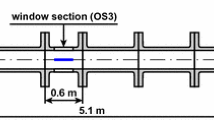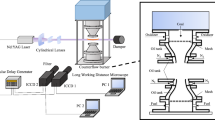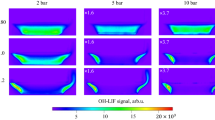Abstract
A strategy to image the preheat zone of a very lean, laminar premixed flame (whose equivalence ratio, ϕ, is <0.6) is proposed using acetone-OH simultaneous PLIF. A combination of excitation at 283 and 266 nm is accomplished by a YAG-Dye laser and fluorescence signals from the acetone seeded into the fuel flow and the combustion-generated OH together detected by a single ICCD camera. Clear “non-signal zone” between these sources is successfully imaged even under very lean conditions, where the flame is blown off without a flame holder. 1-D numerical simulations with detailed chemistry, including seven-step acetone-decomposition reactions are performed for comparison with measured 1-D fluorescence signal distributions. These comparisons clearly indicate that the thickness of the observable “non-signal zone” is much wider than the zone where neither the predicted acetone nor the OH exists. It is found that this deviation is caused by the strong temperature dependence of the acetone fluorescence signal. This feature suggests that the observable “non-signal zone” should correspond to the region with the spatial variation of temperature in the unburned zone; namely, the preheat zone. In fact, it is shown that the observable “non-signal zone” agrees well with the preheat zone obtained by numerically simulated temperature profiles over a range of imposed very lean condition (ϕ > 0.54). Therefore, acetone-OH simultaneous PLIF presents itself as a promising technique capable of visualizing the preheat zone without knowledge of the temperature distribution, even at the near-extinction limit.
Graphical Abstract











Similar content being viewed by others
Notes
In this study, the averaged flow rate is 0.5 m/s, so that it takes about 20 ms for the mixture gas to reach the temperature-measured location (10 mm above the surface). If the diffusion rate of the fuel to air is roughly estimated as 0.22 cm2/s and the diffusion length scale is 8.0 mm (corresponding to the burner width), then the characteristic time for diffusion transport is estimated to be 2.9 s. This is several orders of magnitude larger than 20 ms (i.e., fuel residence time), therefore, the flame structure obtained at a height of 10 mm should be comparable to the theoretical 1-D flame structure (with negligible dilution effects to the surroundings due to diffusion).
References
Barlow RS (2007) Laser diagnostics and their interplay with computations to understand turbulent combustion. Proc Combust Inst 31–1:49–75
Bray KNC (1996) The challenge of turbulent combustion. Proc Combust Inst 26:1–26
Buschmann A, Dinkelacher F, Schäfer T, Schäfer M, Wolfrum J (1996) Measurement of the instantaneous detailed flame structure in turbulent premixed combustion. Proc Combust Inst 26:437–445
Chen Y-C, Mansour MS (1998) Investigation of flame broadening in turbulent premixed flames in the thin reaction-zones regime. Proc Combust Inst 27:811–818
Dégardin O, Renou B, Boukhalfa AM (2006) Simultaneous measurement of temperature and fuel mole fraction using acetone planar laser-induced fluorescence and rayleigh scattering in stratified flames. Exp Fluids 40:452–463
Kaskan WE (1957) The dependence of flame temperature on mass burning velocity. Proc Combust Inst 6:134–143
Kiefer J, Li ZS, Seeger T, Leipertz A, Aldén M (2009) Planar laser-induced fluorescence of HCO for instantaneous flame front imaging in hydrocarbon flames. Proc Combust Inst 32–1:921–928
Kortschik C, Plessing T, Peters N (2004) Laser optical investigation of turbulent transport of temperature ahead of the preheat zone in a premixed flame. Combust Flame 136:43–50
Li ZS, Afzelius M, Zetterberg J, Aldén M (2004) Applications of a single-longitudinal-mode alexandrite laser for diagnostics of parameters of combustion interest. Rev Sci Instrum 75–10:3208–3215
Li ZS, Kiefer J, Zetterberg J, Linvin M, Leipertz A, Bai XS, Aldén M (2007) Development of improved PLIF CH detection using an alexandrite laser for single-shot investigation of turbulent and lean flames. Proc Combust Inst 31–1:727–735
Li ZS, Li B, Sun ZW, Bai XS, Aldén M (2010) Turbulence and combustion interaction: high resolution local flame front structure visualization using simultaneous single-shot PLIF imaging of CH, OH, and CH2O in a piloted premixed jet flame. Combust Flame 157:1087–1096
Manome S, Nakamura Y, Hayashi N, Yamamoto K, Yamashita H (2007) Study of acetone-OH simultaneous PLIF for combustion diagnostics of turbulent flames. Trans JSME Ser B 73–725:350–356
Mansour MS, Peters N, Chen Y-C (1998) Investigation of scalar mixing in the thin reaction zones regime using a simultaneous CH-LIF/Rayleigh laser technique. Proc Combust Inst 27:767–773
Nakamura Y, Manome S, Satomi T, Hayashi N, Yamashita H (2005) Flame diagnostics with acetone-OH simultaneous PLIF. J Comb Soc Jpn 47–142:290–299 (in Japanese)
Nakamura Y, Manome S, Yamashita H, Hayashi N (2006) Diagnostics on local extinction in ultra-lean combustion via acetone-OH simultaneous PLIF approach. In: Proceedings of WIPP at 31st international symposium Combustion Heidelberg, WIPP_5A-03, 480
Nakamura Y, Manome S, Yamashita H (2008) Imaging and diagnostics of turbulent methane-air premixed flames by acetone-OH simultaneous PLIF. J Vis 11–1:71–78
Nakamura Y, Yamada Y, Hirota M, Saito T (2011a) Strategy to diagnose ultra-lean (ϕ < 0.6) premixed flames by acetone-OH simultaneous PLIF with one-laser and one-detector combination. J Vis 14–1:75–84
Nakamura Y, Yamada Y, Hirota M, Saito T (2011b) Flame diagnostics via acetone-OH simultaneous PLIF—a challenge to control “ultra-lean” combustion. Trans Vis Soc Jpn 31–120:3–8 (in Japanese)
Peters N (1999) The turbulent burning velocity for large-scale and small-scale turbulence. J Fluid Mech 384:107–132
Poinsot T, Veynante D (2005) Theoretical and Numerical Combustion. R.T. Edwards, Inc., Philadelphia
Sato K, Hidaka Y (2000) Shock-tube and modeling study of acetone pyrolysis and oxidation. Combust Flame 122:291–311
Suntz R, Becker H, Monkhouse P, Wolfrum J (1988) Two-dimensional visualization of the flame front in an internal combustion engine by laser-induced fluorescence of OH radicals. Appl Phys B 47:187–293
Tanahashi M, Tsukinari S, Saito T, Miyauchi T, Choi G-M, Ikame M, Kishi T, Harumi K, Hiraoka K (2002) On the sound generation and its control in turbulent combustion field. In: Proceedings of 3rd Symposium on smart control of turbulence. http://www.turbulence-control.gr.jp/sympo_j/FY2001/
Thurber MC, Grisch F, Kirby BJ, Votsmeier M, Hanson RK (1998) Measurements and modeling of acetone laser-induced fluorescence with implications for temperature-imaging diagnostics. Appl Opt 37:4963–4978
Vagelopoulos CM, Frank JH (2005) An experimental and numerical study on the adequacy of CH as a flame marker in premixed methane flames. Proc Combust Inst 30–1:241–249
Zhao F-Q, Hiroyasu H (1993) The applications of laser Rayleigh scattering to combustion diagnostics. Prog Energy Combust Sci 19:447–485
Acknowledgments
This work is supported by year 2008 General Sekiyu Research and Development Encouragement and Assistance Foundation, year 2008–2009 TEPCO Research Foundation, year 2009–2010 Steel Industry Foundation for the Advancement of Environmental Protection Technology, year 2009 The Iwatani Naoji Foundation’s Research Grant, year 2009 Research Foundation for the Electrotechnology of Chubu (RFEC); all operated by YN as PI. The authors would like to thank Mr. Ito and Mr. Tsuji (MIT) for their assistance in conducting experiments and Dr. Gollner at UCSD for fruitful discussions and kindly polishing the entire manuscript.
Author information
Authors and Affiliations
Corresponding author
Rights and permissions
About this article
Cite this article
Nakamura, Y., Yamada, Y., Hirota, M. et al. Successful imaging of the preheat zone of a lean (ϕ < 0.6) flame: the potential capability of acetone-OH simultaneous PLIF to diagnose flames at the near-extinction limit. J Vis 15, 281–291 (2012). https://doi.org/10.1007/s12650-012-0134-1
Received:
Accepted:
Published:
Issue Date:
DOI: https://doi.org/10.1007/s12650-012-0134-1




